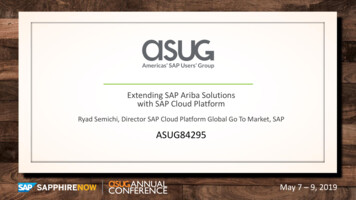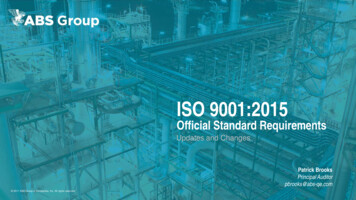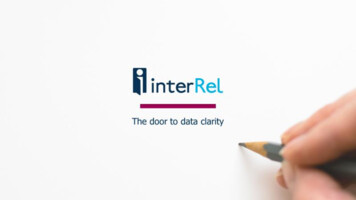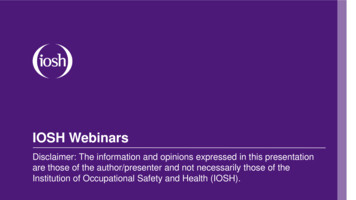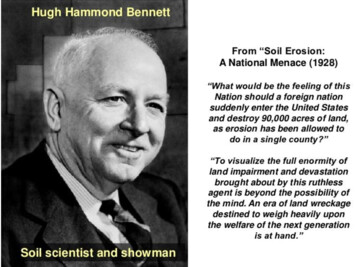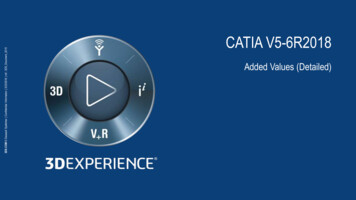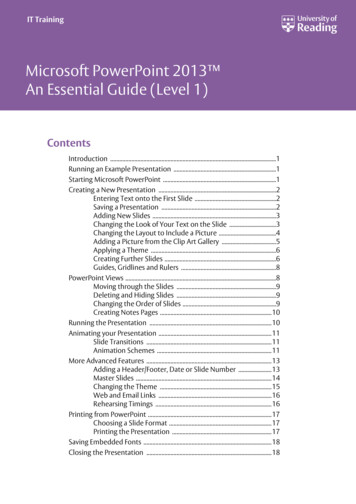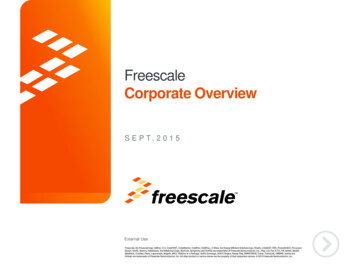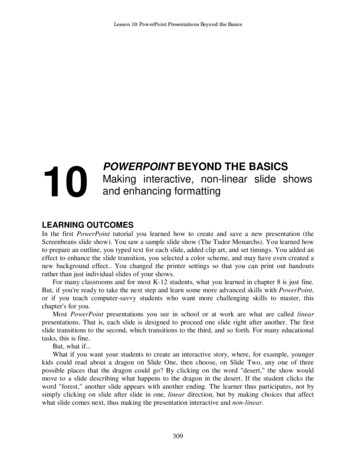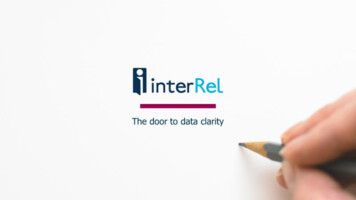
Transcription
Oracle Analytics Partner of the Year
interRel Highlights and Company OverviewFocused onEPM & BIsince1997Awards#1 EPM Cloud Partner170 Cloudspecializations, 60 free Cloud webcasts,free Cloud videos, and2 Cloud books! Ourconsultantsaverage 9 years of EPMexperienceIndustriesHealthcare, FinancialServices, Higher Ed, Retail &Wholesale, Tech & Telecom,Consumer Goods, Energy,Insurance, & Manufacturing2019 Oracle Analytics Partner ofthe Year2016 Oracle Global Partner of theyear – Cloud EPM & BI4-time Oracle Excellence Award9-time Inc. 5000 – list of fastestgrowing U.S. private companiesMultiple Kscope Top SpeakerawardsFree EducationOTN tours, regionalroadshows, weeklywebcasts, Play ItForward videos(YouTube), newsletters,and blog posts!Company was foundedon Essbase and hasthemost experiencedEssbase resources.1,000 EPMprojectscompleted, 50 inEPM Cloud
Taking Control of YourHierarchies with Enterprise DataManagement Cloud (EDM)
Why do we need EDM?
What is Master Data? Master data is shared acrosssystems̶̶E.g., Organization, Accounts, CustomersTransaction / Operational SystemsReporting / Analysis Systems̶ Data is defined through a series ofrelationships and properties:̶̶̶DimensionsHierarchiesAttributes Business rules are necessary tocontrol and manage datarelationships
What is Master Data? Not transactional data or fact data Transaction data - reference data which provides context to abusiness transaction Master data – common data elements shared across transactions,shared data for business decisionsX
What is a Dimension? Dimensions define how data is grouped,categorized, and aggregated Dimensions often reside in reportingand analytical applications (DW, OLAP,BI) Dimension elements are intrinsicallylinked to operational systems Dimensions typically consist of elementsfrom multiple data domains̶HR / HCMERPFAiFlexCRMOtherGeneralLedgerProducts to locations, or customers toterritories Flavors of dimensions̶̶Multi-dimensionalOther XML Excel TextSource: OracleDifferent business units or functions oftenwant their own “flavor” of a dimensionDifferent targets or functions often want theirown “flavor” of a dimensionData Warehousesand Data Marts
Real World ChallengesSignificant manual effort required to close the booksNon-standard reportingNo common hierarchiesLack of flexibility when doing acquisitionsTool of choice for consolidating numbers was ExcelMultiple disparate data repositories and reporting applicationsNon-standard business rules and processesLost confidence in the accuracy and integrity of reporting and analytical dataLack of ownership and accountability for defining business rules and troubleshooting errorsAnomalies in the data were resolved on a one-off manual basis by a handful of over-committedresources Business analysts request data from various sources to complete reporting using multipletoolsets and techniques Meetings were spent comparing data sources and arguing about whose data was correct
Mapping, Consolidating, Reconciling Multiple Chart of AccountsManagement Accounting &Performance Reporting1 – Assets1.1 – Short Term Assets1.1.0 – Other Short Term Assets1.1.1 – Cash1.1.2 – Cash Equivalent1.2 – Long Term Assets1.2.0 – Other Long Term Assets1.2.1 – Research1.2.2 – Advertising1.2.3 – Inventory2 – Liabilities3 – EquitySAP Balance Sheet (IFRS)100-000 – Assets100-100 – Short Term Assets100-110 – Cash100-120 – Cash Equivalent100-200 – Long Term Assets100-210 – Research100-220 – Advertising100-230 - Inventory200-000 – Liabilities300-000 – EquitySource: Oracle10000 – Assets11000 – Short Term Assets11100 – Cash11200 – Cash Equivalent15000 – Long Term Assets15100 – Embedded Derivatives15300 – Inventory20000 – Liabilities30000 – EquityPeoplesoft Balance Sheet (USGAAP)
Dimension Maintenance Nightmare Complex and confusing!!! Cloud and on-premReporting & Analysis ToolsStandard Reports, Adhoc Analysis, Data Mining, Dashboarding & Performance ScorecardsPBCSAnalytic EnginesHFM Multiple ways to maintainhierarchies across thecompany Inefficient, inconsistentmaintenance processes IT vs. Business users Limited securityData Warehouse Limited checks andvalidation processes Limited auditability Limited accountabilitySource SystemsGLHRLegacyOtherSupplyChain Data integrity issues Single version of thetruth? Compliance risk
Corporate Restructures It’s that time again Management is going to reorganize the enterprise for reasons X, Y,and Z All you know is that attempting this in a spreadsheet is going to bea nightmare̶̶̶̶Creating new departmentsMoving cost centersRunning comparisons between new and old structurePutting in checks to ensure business rules for the reorg
EDM to the RescueIntroduction to Enterprise Data Management Cloud Service
Enterprise Data Management Cloud Service (EDM) Allows business users to managemaster data (dimensions,hierarchies, etc.) Provides audit controls andaccountability Allows synchronization of masterdata across all systems System validations and verificationsto control hierarchies Compare and easily update sharedhierarchies and dimensions Subscriptions & node typeconverters to manage master dataacross source and targets Approval policies & collaborativeworkflow
EDM: Central Place to Manage Dimensions, Hierarchies, AttributesOracle AnalyticsCloud (OAC)Planning CloudFinancial ConsolClose CloudEssbase CubesEnterprise DataManagement CloudService (EDM)ERPManage common dimensions, hierarchies,attributes, & mappingsBusiness user driven toolArchived hierarchy versionsAudit trailFinancials Cloud
Key EDM Cloud Features Manage dimensions, hierarchies, properties,attributes by business users Next generation DRM; new data model design Business user tool / Modern graphical user interface Request driven batch of related changes Compare, rationalize, and conform structural changes Visualize and analyze impact of changes beforecommitting Drag and drop hierarchy management with subscriptionsand node type converters Granular change audit Granular security by application, dimension, node type, orhierarchy set. Push hierarchies into EPM Cloud apps directly and toother custom apps via exports Push mappings into Data Management
Part of 4 Main Business Processes Shift away from cloud services to 1 solution that supports 4 mainbusiness processes̶̶This does mean that except for legacy customers, the products will not be soldseparatelyWhat was a “product” is now just a “business process” inside Oracle EPM Cloud1. Planning: Planning, Profitability2. Financial Close: Financial Consolidation, Account Reconciliation, TaxReporting3. Narrative Reporting: Narrative Reporting4. Enterprise Data Management: Enterprise Data Management nagement/products.html
New Names of EPM Products (“Business Processes”) EPBCS/PBCS – Planning FCCS – Financial Consolidation and Close ARCS – Account Reconciliation EPRCS – Narrative Reporting PCMCS – Profitability and Cost Management TRCS – Tax Reporting EDMCS – Enterprise Data Management
Oracle EPM EnterpriseAd HocPLANNING Custom Plan Types Workforce Projects CapEx Scenario Modeling Financials Freeform (Essbase) GroovyERPsNarrationManagement ReportsProfitability & Cost ManagementENTERPRISEDATAMANAGEMENTData WarehousesMobileFINANCIAL CLOSE Consolidation Account Reconciliation Task Management Supplemental Data Advanced Consolidation Transaction Matching Tax ReportingUnstructured DataExcel
EPM Cloud Standard vs. EnterpriseBusiness ProcessesEPM Cloud StandardEPM Cloud EnterprisePlanningPlanning & BudgetingPackaged modules: Workforce,Capital, Financial ProjectPlanningScenario Modeling1 Custom Hybrid BSO & 1Custom ASO Advanced Customization andmodeling (Groovy)Intelligent Performance ManagementIntelligent Process AutomationFree Form PlanningFinancial Consolidation & Close Financial Consolidation Advanced consolidation (ondemand business rules, customcalculations)Intelligent Performance ManagementIntelligent Process AutomationNarrative ReportingNarrative Reporting XBRL ReportingAccount ReconciliationAccount Reconciliation Transaction MatchingTax ReportingNot availableTax ReportingProfitabilityNot availableProfitability and Cost ManagementEnterprise Data ManagementNot availableEnterprise Data Management with5,000 records limitTask Management
EDM is part of EPM Enterprise Cloud You can create as MANY applications of EACH Business Process as you need.̶̶10 Planning, 2 Financial Consolidation & Close, 3 Tax Reporting, 5 Narrative Reporting, 2Account Reconciliation, and 4 Profitability applications. no issues.Go for it. all included in the pricing for EPM Enterprise Cloud What, six months later you realize you need 5 more Planning and 2 moreNarrative Reporting?̶Contact Oracle and they’ll give them to you. all still included in the base price of EPMEnterprise Cloud. Want Disaster Recovery environments. they are also included with same termsand conditions as the additional, old SKU for this service. All advanced/premium features are included in the EPM Enterprise Cloud̶̶E.g. Groovy rules, advanced consolidations, transaction matching, disclosure management,Intelligent Performance Management, Free Form Planning (Essbase)Enterprise Data Management (5000 records; additional available)
What’s the price? How much does this cost?
How to Subscribe to EDM The Enterprise Edition does have a maximum 5,000 records includedfor Enterprise Data Management, but you can buy more. You can also continue to purchase EDM separately
Views
Home Page
Completely New Design / Data Model
Understanding Data Chain / Model – Helpful Analogy Node Types and Hierarchy Sets are like Tables in RDB Node Sets, Views, and View Points are like Views̶̶Node Sets filterViews and view points present / presentation layer
Views
Opened View Displaying View Points
List Dimension Example
Search for Nodes
Inspect View Point Inspect to review definition and edit view point You can inspect all over the place in EDM Cloud; really helpfulfeature
Download View Point to a File
Demo: Basic View Point Navigation
View Point Definition Admins can define how users interact with data in the view point
New RequestsShopping Cart Experience for Users
Create New Requests
Create New Requests Rename the request from an assigned number
Create New Requests: Add Top Node
Create New Requests: Change Property Values
More Requests
Create New Requests: Delete Nodes
Create New Requests: Hyperlink to View Proposed Change
Create New Requests: Node Action Options
Demo: Create Requests
Demo: Create Request – Alternate Rollup
Create Request – Load Changes from a File Benefit of using this option to import data̶̶Excel fileTracked through requests Worksheet name must match the dimension name beingimported Headers in Excel must match column headers defined inNode Type
Create Request – Load Changes from a File
Demo: Create Request – Load Changes from a File
Create Request: Check Invalid Requests & Fix
Create Request FeaturesView and addattachmentsView issues withproposed changesHyperlink to issueView list of proposedchangesHyperlink to proposedchangeAdd comments
Demo: EDM Mappings
View Previous Requests
View Previous Request
View Previous Request
View Previous Requests
View Previous Requests
Demo: Compare Hierarchies
Demo: Find Missing Nodes and Assign
Import & Export “Data”In EDM, data is the dimensions/hierarchies/propertyvalues/mappings
Import Data from Applications
Import Data from Applications CSV
Import Data from Applications: Import from File
Import Data from Applications: Import from Connection
Review the Imported Hierarchy in Default View
Export Application Export Application Export Mappings
Export
Register Applications
How EDM Applications Work with Subscriptions (example - OAC/PBCS)EDMApplicationsMasterappCube 1EnterpriseDataManagement CloudService(EDM)Cube 2Cube 0(ASO)Ess1HybridOracle AnalyticsCloud (OAC) 1 EDM Application targetcube Subscriptions work with loadrequests̶Essbase CubesEss2(ASO)̶̶Cube 3Cube 4PT2PT3Cube 5̶PT1Planning BudgetingCloud (PBCS)View points to subscribe tochanges into another view point(can cross EDM applications)Add new / make change once andthe subscribed viewpoints willupdateNew request - in all viewsCommit in master; auto commit insubscribed views Update once and subscriptionsupdate to
Applications
Register a New Application
Demo: Review Registered Application
Conclusion
10 Steps to Implementing EDM1. Train2. Setup3. Requirements & Design & Prototype4. Create EDM Application(s)5. Define user interfaces (views and view points)6. Define node type converters & subscriptions7. Import dimensions and properties8. Setup security and workflow9. Automation10.Migration & Deployment
EDM: Manage Dimensions, Hierarchies, AttributesConnection to inbox/outbox to share dimsOracle AnalyticsCloud (OAC)PlanningBudgeting Cloud(PBCS/E)PCMCS / FCCSFuture connectionCustom flat file for nowEssbase CubesFuture connectionCustom / flat file for nowEnterprise DataManagement CloudService (EDM)Connection to inbox/outbox of DataManagement (mappings & dims)ERPManage dimensions, hierarchies, attributes, &mappingsBusiness user driven toolArchived hierarchy versionsAudit trailOther
Questions & Answers
Continuing Education
Best Selling Oracle BI & EPM BooksOAC Steps to set up your OracleAnalytics Cloud instance How to build Essbase Cloudcubes from start to finish Maintaining dimensions andloading data Creating calculations andcalculating data Assigning securityPlanning Build an Oracle Planning &Budgeting Cloud Application from start to finish Administer
Essbase resources. Our consultants average 9 years of EPM experience Focused on EPM & BI since 1997 #1 EPM Cloud Partner Industries Healthcare, Financial Services, Higher Ed, Retail & Wholesale, Tech & Telecom, Consumer Goods, Energy, Insurance, & Manufacturing 2019 Oracle Analytics Partner of the Year 2016 Oracle Global Partner of the year –Cloud EPM & BI 4-time Oracle .

